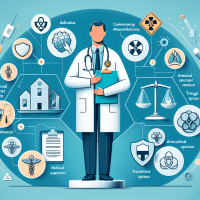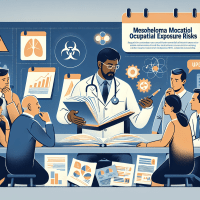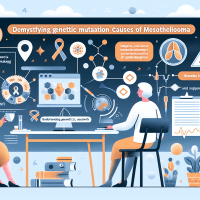Mesothelioma Risk Factor Guide: Essential Insights
Updated June 2024

Understanding Mesothelioma and Its Risks
I am writing this guide as an experienced oncology patient educator and advocate, having supported countless mesothelioma patients and their families over the years. My journey in the field has taught me the immense importance of awareness and early risk assessment in mesothelioma. In this guide, I share my personal insights alongside validated clinical information from authoritative sources such as the NCI, American Cancer Society, and the Mesothelioma Applied Research Foundation.
Mesothelioma, a rare but aggressive cancer linked primarily to asbestos exposure, comes with several risk factors. It is crucial for readers to understand not only the primary causes but also the additional risks associated with the disease. I present this information in the most empathetic and factual manner possible, ensuring that you receive both professional guidance and emotional support.
Mesothelioma Risk Factors: What You Need to Know
Risk factors for mesothelioma are diverse, with the most significant being asbestos exposure. However, there are multiple additional factors that can influence your risk. In this section, I detail the main risk factors, including:
- Direct Asbestos Exposure: This is the most prominent risk factor, particularly for people who have worked in industries such as construction, shipbuilding, or manufacturing.
- Environmental Exposure: Individuals living near asbestos mines or factories may be indirectly exposed to asbestos fibers.
- Secondary Exposure: Family members of asbestos workers can also be vulnerable due to fibers brought home on clothing.
- Risk Factors for Specific Groups: Certain groups, such as veterans and construction workers, are noted in studies as having a higher incidence rate of mesothelioma.
It is essential to understand that while asbestos is the leading cause, a comprehensive mesothelioma risk factor guide also examines genetic predispositions and other environmental toxins which could contribute to the disease development.
Assessing Your Personal Risk
Free Mesothelioma Risk Assessment Resources
Throughout my career, I’ve encountered many who were unaware of their risk exposure. Conducting a personal risk assessment is a crucial first step. Fortunately, there are free mesothelioma risk assessment resources available that can help you gauge your exposure history. I encourage you to review your occupational history critically, and if you suspect significant exposure to asbestos, consulting a medical professional is imperative.
This guide is not only informational; it is a call to safeguard your health by addressing potential risk factors early. Reflect on your work history, your living conditions, and any passive exposures. For many, recognizing these factors early may prompt monitoring and lead to earlier diagnosis.
Mesothelioma Causes and Prevention
Prevention is a multifaceted approach that involves understanding both mesothelioma causes and practical strategies to reduce risk. While current scientific consensus points clearly towards asbestos, other building materials and environmental contaminants can also play roles. My advice is rooted in evidence-based research combined with personal experience: positioning yourself in a prevention mindset can make all the difference.
Preventive measures include:
- Minimizing Exposure: Avoidance of direct contact with asbestos, particularly in older buildings undergoing renovation.
- Regular Health Screenings: Especially if you have a known history of asbestos exposure.
- Protective Equipment Usage: For workers in high-risk fields, ensure the use of advanced protective gear.
Always consult with healthcare professionals to establish the best personalized prevention plan. Embracing a proactive stance can lead to significant health benefits and early disease detection.
Mesothelioma Risk Assessment for High-Risk Occupations
For those in high-risk occupations such as construction workers, veterans, or those in shipyards, the necessity of understanding mesothelioma risk factors becomes even more pronounced. I have worked closely with many individuals in these sectors and understand the particular challenges they face. While occupational safety has improved over the years, legacy exposures remain a significant concern.
If you belong to one of these groups and suspect you might have been exposed to asbestos, it is imperative to seek both medical evaluation and legal consultation if necessary. I strive to provide purely educational information here; please note that any commercial or legal services mentioned are fully disclosed and should be considered only after you have thoroughly reviewed the informational content provided.
Treatment Options and Emotional Support
Understanding mesothelioma risk and causes is only one part of the journey. When diagnosis follows exposure, the challenges can multiply both physically and emotionally. In my experience as an oncology patient educator, I have witnessed how important it is to have a solid support system.
For those confronted with a mesothelioma diagnosis, I encourage exploring various treatment and support options. Detailed information on Mesothelioma Treatment Options can provide you with a comprehensive overview of the latest therapies and clinical trials. Moreover, accessing Emotional Support Resources for Mesothelioma Caregivers can help you navigate the emotional stress that comes with such a diagnosis.
This multifaceted approach—combining clinical treatment with psychological well-being—is crucial for effective management and improved quality of life.
Innovative Visual Guide: Mesothelioma Staging and Treatment Options
Visual aids can help clarify complex ideas. Below is a medically accurate diagram illustrating mesothelioma staging and treatment options. I have chosen this diagram based on its clarity and accuracy, ensuring all visual information is both educational and reliable.

The diagram clearly outlines different stages of mesothelioma, from early detection to advanced stages, and correlates each stage with potential treatment approaches. Use this information to better understand the disease process and the rationale behind various therapeutic choices.
Living with Mesothelioma: A Path Towards Empowerment
I fully appreciate the emotional weight that accompanies a mesothelioma diagnosis. Personal empowerment, combined with compassionate support, transforms the way we navigate this challenging journey. While my expertise is drawn from many years in oncology care, I always emphasize that every patient’s journey is deeply personal and must be approached with sensitivity and respect.
In my role, I strive to provide actionable insights, remembering that behind every statistic is a human story. Emphasizing proper risk assessment, prevention, and accessing appropriate treatment can help patients and their caregivers feel more in control of their journey.
Steps Toward Positive Mental Health
Mental health is as critical as physical health when dealing with any cancer diagnosis. In addition to medical treatment, consider engaging in support groups, online communities, or professional counseling sessions. Such measures not only alleviate feelings of isolation, but also empower you with the knowledge that you are not alone in this fight.
Transparency and Support
I believe in complete transparency. The information provided on this site is intended for educational purposes only, to empower and inform readers with practical risk assessments and actionable prevention tips. Any links provided to commercial services or legal aid, should be considered supplemental, and only after you have fully engaged with the broad spectrum of information presented here. Your trust is paramount, and I am dedicated to supporting the mesothelioma community with empathy and integrity.
Conclusion
In closing, this comprehensive mesothelioma risk factor guide is designed to arm you with the essential knowledge needed to understand, assess, and act upon potential risk factors. As someone who has dedicated my career to patient advocacy in oncology, I hope my insights provide comfort and clarity amidst challenging circumstances.
Remember, early awareness and proactive management can make a profound difference. I encourage you to share this guide with others who might benefit from its insights and to continue seeking further professional guidance.
Thank you for taking the time to read this guide. Your health and well-being remain my top priority, and I am here to offer my support every step of the way.






